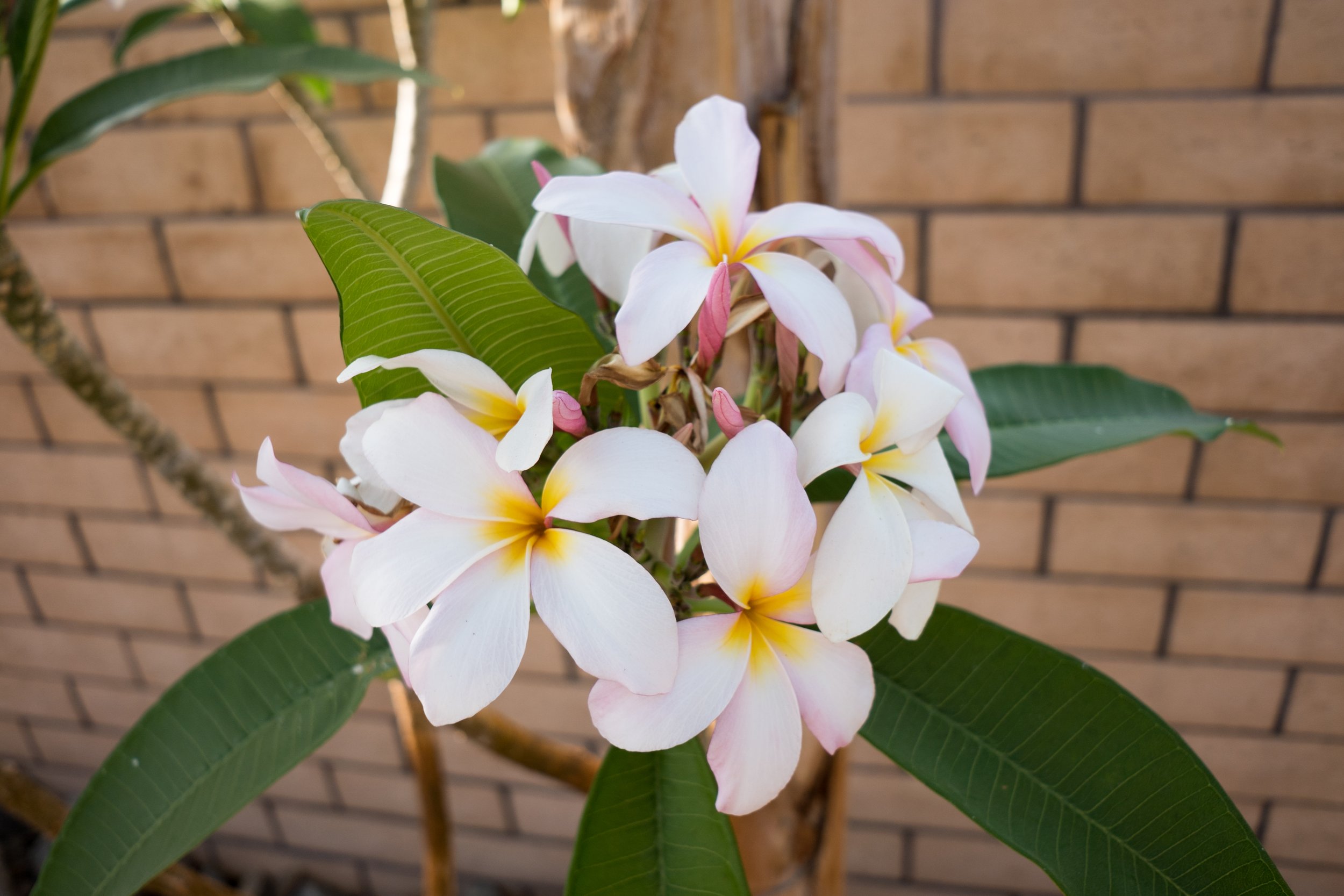Plumeria
Originating from the Americas, plumerias have quickly spread worldwide.
The heavenly scent and striking flowers captivated the attention of many and became religious, cultural, and national emblems.
If you're thinking that this tropical-looking plant can only be enjoyed indoors in an arid region, you'd be surprised! These tough plants actually do quite well in the Palm Springs area.
Botanical name: Genus is plumeria. The variety we carry is Plumeria Rubra.
Other names: Frangipani, champa, melia
Close up look at Plumeria rubra
TABLE OF CONTENTS
Plumeria Appearance
Although plumerias can grow to over 20 feet tall, in the Palm Springs area, they are typically shorter- 10 feet or so.
The main trunk and branches are brown, gray, or slightly green when photosynthesizing.
A cluster of leaves and flowers appear at the end of each branch.
Tropical-looking leaves vary in shape and color depending on the plumeria variety. Plumeria Rubra has leaves that start with a red and green color that develops into deep green. The long, curved leaves taper into a pointed tip. In contrast, Plumeria obtusa (Singapore plumeria) has round leaves and Plumeria stenophylla has long narrow leaves.
The majority of plumerias are deciduous, dropping their leaves in the winter, and regrowing them in spring.
Iconic flowers with strong and sweet fragrance, especially in the evening. Typically 5 petals in each flower overlap each other and are thick and waxy. Flowers are commonly white, yellow, pink, red, or a combination of different colors.
Long, leathery, dark-colored seedpods may form, but they are not very common.
Plumeria Landscaping Tips
Place plumerias where tropical look and scent can be enjoyed.
Will attract pollinators such as bees and moths when in bloom.
Enjoy the long-blooming season- typically from late spring to fall in the Coachella Valley.
Sheds leaves and flowers. The majority of plumerias are deciduous, so they will have bare stems in the winter.
To keep visual interest year-round, you could plant them with or near evergreens.
Since they're heat tolerant, you could strategically have the plumerias provide filtered shade for smaller plants during the summer. The smaller plants below the plumerias would get more sunlight when the temperatures are cooler during winter when the plumerias have no foliage.
Drought-tolerant once mature. High salt tolerance. Good container plant.
Contains white toxic sap. Wear gloves when handling.
Flowers can be used for arts and crafts, decorations, and potpourri. Plumerias are famously known for being used in leis in Hawaii and other Pacific islands.
Large plumerias for sale at the nursery
Plumeria Origin
Plumerias are from temperate regions in the Americas such as the Caribbean, Brazil, Florida, and Mexico.
Plumeria Care
Soil: Loose, well-draining soil. Use a fertilizer formulated for blooms (high P content in N-P-K fertilizer ratio) during the growing season.
Temperature: Can withstand temperatures down to frost (= 32 degrees) for a short period of time. Does well in the heat.
Water: Regular watering during the growing season. Allow the soil to slightly dry out between waterings. Either use a moisture meter or stick your finger through the soil to gauge the moisture level. No watering when dormant.
Sun: Full sun for maximum blooms. Partial shade is ok in the Palm Springs area but will bloom less.
Plumeria Problems
Pests: Common pests found on plumerias are mealybugs, spider mites, and thrips.
To remove mealybugs, use insecticidal soap or apply rubbing alcohol directly to the area of infestation using a cotton swab.
To remove spider mites, use horticultural oil for crawlers and insecticidal soap for mites of all stages.
To remove thrips, blast them off with water or use insecticidal soap or neem oil. Repeated application is necessary to disrupt their life cycles.
Whenever using any kind of pesticide, be aware that it can damage the plant if the temperatures are in the 80s or above.
Signs of overwatering: Rotting roots and bottom of trunk, soil that does not dry out
Signs of too little water: Shriveled appearance
Signs of too much sun: Burning, fading leaves
Signs of too little sun: Etiolation, stunted growth
Plumeria Propagation
Propagating a plumeria with cuttings is very easy. The best time to make a cut is in early spring before the plumeria starts to grow leaves and flowers.
Remove a branch using a sterile, sharp blade. Allow it to dry out and callus. Plant in moist soil.
FAQ
How much does a plumeria cost?
At our nursery, plumeria costs $45 for a 5-gallon container, $120 for a 15-gallon container, $250 for a 24” box, and $500 for a 30” box.
Prices are subject to change. Please contact us for the most up-to-date information on pricing. We may have larger sizes available. We provide installation services locally at a separate cost.
Do plumerias need full sun?
Provide full sun for maximum blooms. Partial shade is ok in the Palm Springs area but will bloom less.
What’s the difference between plumeria and frangipani?
Plumeria and frangipani both refer to the same genus of flowers. The name plumeria is derived from Charles Plumier, a botanist who extensively studied plants in the Americas, and the name frangipani is derived from the Frangipani family that created a perfume that smelled similar to the flower.
Why is my plumeria not blooming?
The most likely reasons for a plumeria not blooming are that it is not getting enough sunlight or nutrition. Move it to a place where it can get more sun and/or provide fertilizer formulated for blooms (high P content in N-P-K fertilizer ratio) during the growing season.
Summary
| SIZE (H X W) | 10-20 feet x 10-20 feet |
|---|---|
| FLOWER COLOR | White, yellow, pink, red |
| FLOWER SEASON | Spring to Fall |
| EXPOSURE | Full Sun |
| WATER | Medium |
| GROWTH RATE | Fast |
| HARDINESS | 32º F, USDA Zone 9 |
| PRUNING | None |



